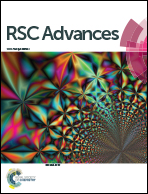Novel bismuth compounds: synthesis, characterization and biological activity against human adenocarcinoma cells†
Abstract
Five new bismuth(III) halide compounds (BiX3, X = Br or I) of formulae {[BiBr(Me2DTC)2]n} (1), {[BiBr2(Et2DTC)]n} (2), {[BiI2(Me2DTC)]n} (3), {[BiI(Et2DTC)2]n} (4) and {[BiI(μ2-I)(Et2DTC)2]2}n (5) (Me2DTCH = dimethyldithiocarbamate, C3H7NS2 and Et2DTCH = diethyldithiocarbamate, C5H11NS2) were synthesized from the reactions between bismuth(III) bromide (BiBr3) or bismuth(III) iodide (BiI3) with tetramethylthiuram monosulfide (Me4tms), tetramethylthiuram disulfide (Me4tds) or tetraethylthiuram disulfide (Et4tds). The complexes were characterized by melting point, elemental analysis, FT-IR spectroscopy, Raman spectroscopy, 1H, 13C NMR spectroscopy and Thermal Gravimetry-Differential Thermal Analysis (TG-DTA). Moreover, the crystal structures of 1–5 were determined with single crystal X-ray diffraction analysis. The ligands of compounds 1–5 were derived from reduction with concomitant degradation to dithiocarbamates. Complexes 1–4 are polymers, whereas complex 5 is a dimer, built up from monomeric units with square pyramidal (SP) geometry (1, 4 and 5) and pentagonal bipyramidal geometry (2 and 3) around the bismuth center. Complexes 1–5 were evaluated for their in vitro cytotoxic activity against human adenocarcinoma breast (MCF-7) and cervix (HeLa) cells. The toxicity on normal human fetal lung fibroblast cells (MRC-5) is also evaluated. Since estrogen receptors (ERs) are located in MCF-7, in contrast to HeLa cells, the estrogenic effect of 1–5 on MCF-7 cells was studied by means of a methylene blue assay. Hirshfeld surface volumes were analyzed to clarify the nature of the intermolecular interactions. Molecules with lower H-all atoms inter-molecular interactions tend to exhibit higher activity against both MCF-7 and HeLa cells. Structure–activity relationship (SAR) studies were performed for these complexes using 2D topological based disparity analysis. This finding underlines the significance of the halogen atoms in the coordination sphere of the metal ion.


 Please wait while we load your content...
Please wait while we load your content...